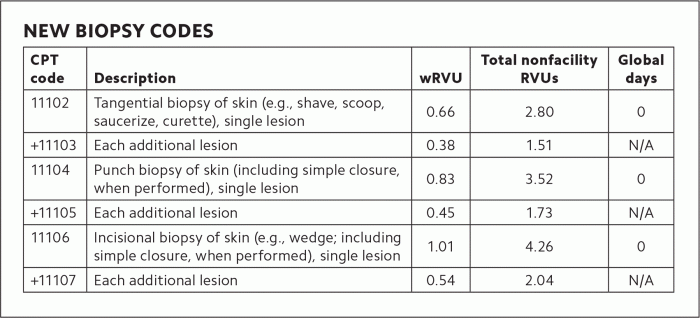Cpt code for biopsy of external ear – The CPT code for biopsy of the external ear is a critical piece of information for medical professionals performing this procedure. Understanding the specific code and its modifiers is essential for accurate billing and reimbursement. This guide delves into the details of the CPT code for biopsy of the external ear, providing a comprehensive overview of its application and significance.
The biopsy of the external ear involves the removal of a tissue sample from the outer part of the ear for examination under a microscope. It is commonly performed to diagnose skin conditions, such as infections, tumors, or other abnormalities.
The CPT code assigned to this procedure is crucial for ensuring proper reimbursement and documentation.
Procedure Overview: Cpt Code For Biopsy Of External Ear

A biopsy of the external ear is a procedure that involves the removal of a small sample of tissue from the external ear for examination under a microscope. This procedure is typically performed to diagnose or rule out skin conditions, infections, or other abnormalities of the external ear.
There are different types of biopsies that can be performed on the external ear, including:
- Punch biopsy: A circular piece of skin is removed using a special instrument called a punch.
- Shave biopsy: A thin layer of skin is removed using a scalpel or razor blade.
- Excisional biopsy: The entire lesion or abnormal area is removed.
CPT Code Details, Cpt code for biopsy of external ear
The specific CPT code for a biopsy of the external ear is 69100.
The following modifiers may be used with this code:
- -50: Bilateral procedure
- -51: Multiple biopsies (more than 10)
- -52: Biopsy of a skin tag or other benign lesion
- -53: Biopsy of a malignant lesion
There are no special circumstances or coding considerations that apply to this code.
Procedure Steps
The steps involved in performing a biopsy of the external ear are as follows:
- Pre-operative preparation: The patient is informed about the procedure and any potential risks or complications. The biopsy site is cleaned and sterilized.
- Anesthesia: Local anesthesia is typically used to numb the biopsy site.
- Incision: A small incision is made at the biopsy site using a scalpel or biopsy punch.
- Specimen collection: The biopsy specimen is removed and placed in a preservative solution.
- Post-operative care: The biopsy site is bandaged and the patient is given instructions on how to care for the wound.
Equipment and Materials
The following equipment and materials are required for a biopsy of the external ear:
- Scalpel or biopsy punch
- Biopsy forceps
- Preservative solution
- Bandage
- Local anesthetic
- Sterile gloves
- Suture material (if necessary)
Anatomical Considerations
The external ear is composed of the auricle and the external auditory canal. The auricle is the visible part of the ear and is made up of cartilage covered by skin. The external auditory canal is a tube that leads from the auricle to the middle ear.
It is lined with skin and contains ceruminous glands, which produce earwax.
When performing a biopsy of the external ear, it is important to consider the anatomy of the area. The biopsy site should be chosen carefully to avoid damaging any important structures, such as the nerves or blood vessels.
Interpretation of Results
The results of a biopsy of the external ear are interpreted by a pathologist. The pathologist will examine the biopsy specimen under a microscope to look for any abnormalities. The results of the biopsy can help to diagnose or rule out a variety of conditions, including:
- Skin cancer
- Infections
- Autoimmune disorders
- Allergic reactions
Complications and Risks
The following are potential complications and risks associated with a biopsy of the external ear:
- Bleeding
- Infection
- Scarring
- Nerve damage
- Pain
The risk of complications is low, but it is important to be aware of them before undergoing the procedure.
Documentation
The following documentation is required for a biopsy of the external ear:
- Preoperative history and physical examination
- Informed consent
- Operative report
- Pathology report
- Postoperative instructions
The operative report should include the following information:
- The date and time of the procedure
- The name of the surgeon
- The type of biopsy performed
- The location of the biopsy site
- The size and appearance of the biopsy specimen
- Any complications that occurred during the procedure
Frequently Asked Questions
What is the CPT code for a biopsy of the external ear?
The CPT code for a biopsy of the external ear is 30200.
What modifiers may be used with the CPT code for a biopsy of the external ear?
Common modifiers used with the CPT code for a biopsy of the external ear include:
- -50: Bilateral procedure
- -51: Multiple biopsies (more than one lesion)
- -59: Distinct procedural service
What are the documentation requirements for a biopsy of the external ear?
Documentation for a biopsy of the external ear should include:
- Preoperative diagnosis
- Procedure details, including the site of the biopsy and the type of biopsy performed
- Pathology report
- Postoperative care instructions
